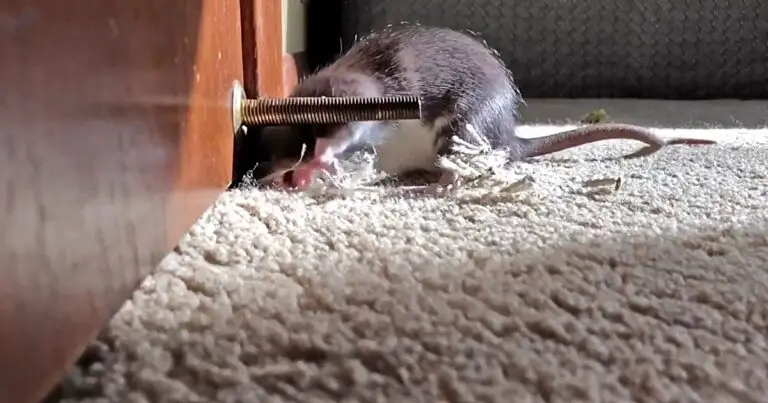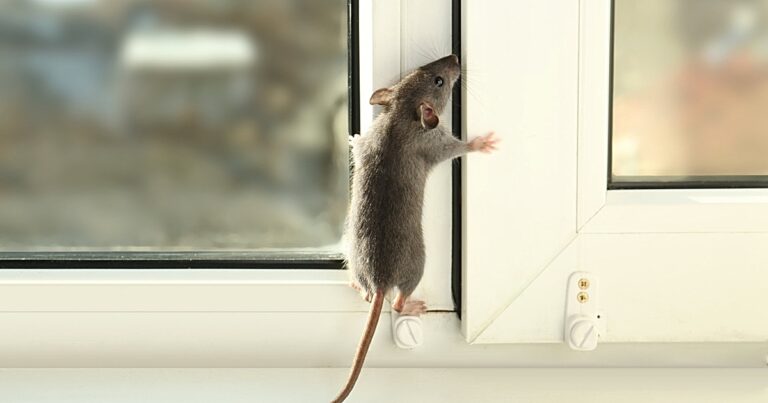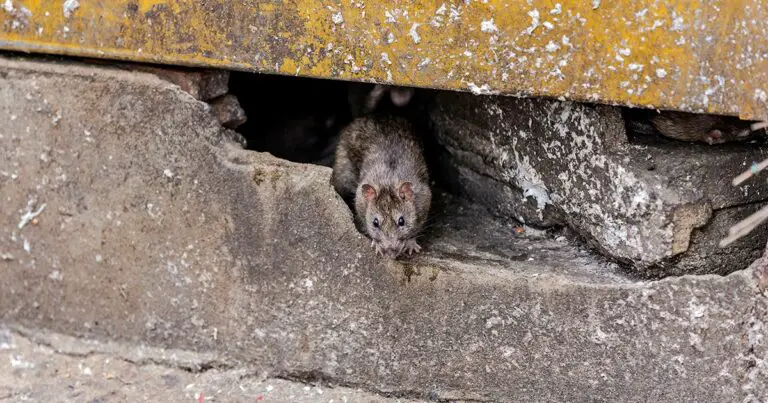How Do Rats Get in the House? (Answered)
There are many ways that rats can get into a house. Rats can enter through cracks in the foundation or walls, they can come up through the sewer system, and they can even be carried in on items like boxes or furniture.
No matter how they get in, once rats are established in a home, they can be very difficult to remove. In this article, we will explore some of the most common ways that rats get into homes, and we will offer some tips for preventing them from entering in the first place.
How Do Rats Get into the House?
Rats are small rodents that can sneak through the smallest cracks. Rats can squeeze under doors and chew through metal and wood. It’s no wonder that they can sneak into our homes.
The most common areas for rats to get into the house include vents, windows, cracks in the foundation, and by chewing through weather stripping to get into a garage. Once they’re in, they’ll set up shop in your walls, ceiling, or floor. Sometimes you might hear them scratching around in your attic or crawlspace.
If you see rat droppings or footprints, that’s a sure sign that you have an infestation. Other signs include gnawed food packages, chewed electrical wiring, and damage to insulation.
How Do Rats Get Inside Walls?
Rats can enter your home through very small openings. All they need is a half-inch opening to squeeze through. Once they’re in, they will nest in your walls, ceiling, or floor.
Rats can chew through metal and wood, so once they’re in it’s easy for them to get behind your walls. They will also chew through insulation and electrical wiring. This can pose a serious fire hazard.
How Do Rats Get in the Attic
Rats typically will find their way into your attic by getting onto your roof from trees and finding an opening into your home. The most common entry points to the attic are unscreened vents on the roof and gaps in the eavestrough. Once they’re in, rats will build their nests and have their young.
An attic is a perfect place for rats because there are perfect nesting materials and they’re usually safe in the attic. If you have rats in your attic, you may hear them scratching around at night. You might also find their droppings or footprints. If you see any of these signs, it’s time to call a pest control professional to get rid of the rats.
How Do Rats Get in the Garage
Rats get into the garage from other access points in your home if you already have an infestation or by chewing the weather stripping to get into the garage. Once they’re in, they’ll set up shop and build their nests.
The best thing to do is set up traps and replace the weather stripping as soon as possible. If you don’t have an infestation yet, make sure to seal any cracks or holes that rats could use to get into the garage. This will help keep them out.
Signs of Rats Getting into Your Home
Several signs indicate you have rats getting into your home:
- You see rat droppings or footprints.
- You hear scratching sounds in your walls, ceiling, or floor.
- You find gnawed food packages or chewed electrical wiring.
- You see damage to insulation.
If you hear scratching sounds in your walls, that’s a good indication that you have rats. You might also see rat droppings or footprints. If you see these signs, it’s important to take action right away to get rid of the rats.
Where Do Rats Hide in a House?
Once rats are inside your home they look for a nice, quiet, and cozy place to build a nest. Some of the most common places for a rat nest include inside the walls, under floorboards, in attics and lofts, in crawlspaces, and in kitchens and laundry rooms.
Rats will try to be as close to water and food sources without being seen or caught. They also gravitate to large appliances like stoves, dishwashers, washing machines, and dryers. Large appliances produce a lot of heat that draws rats and keeps them warm.
Will Rats Come into a Clean Home?
If you’re wondering, “can clean houses get rats?” the answer is yes. Rats will especially enter a clean home during the winter to seek warmth. It gets even more difficult to vacate rats if they’re able to find food and water in your home.
Rats don’t need to eat much so any scrapes or untended garbage will be a huge incentive for them to feed and nest in your home.
If you have a clean house and take your garbage out every night but still have rats, it’s okay. You just need to follow a few steps to find and remove the rats. Once all the rats are removed, make it more difficult for them to get in the house.
How Do You Stop Rats From Coming into Your House?
Knowing how to stop rats from getting into your house depends on how they’re finding their way inside in the first place. However, if you have a rat infestation, it’s good to fix all of the following:
- Install gutter guards in all the eavestroughs
- Replace weather-stripping
- Fill any holes, cracks, and gaps (use wood filler to fill any wood, replace drywall if need be, and use steel wool and silicone to fill any large holes where you see fit)
- Repair any plumbing leaks throughout the house
- Remove any food sources (take the compost out every night and make sure the outdoor compost bin is sealed and locked)
- Trim tree branches and shrubs (so rats can’t leap onto your roof)
If you follow these steps, you should be able to keep rats away from your home for good. If you have any questions or need help, don’t hesitate to call a pest control professional.
How Do I Get Rid of Rats in My House Fast?
The fastest and most effective way to get rats out of the house is to call an exterminator or pest control expert. You can also remove them on your own but you need to be cautious about how you go about removing the rats. Rats can carry diseases and parasites that can affect the health of your pets and family.
If you plan on removing rats from your home by yourself, it’s suggested that you use the proper safety equipment. Wear protective goggles when dealing with any rat poisons and wear gloves when dealing with anything that the rats might have come in contact with. Make sure to wash your hands each time that you touch any traps or baits.
Some of the most common at-home techniques to remove rats include:
- Relocating (most humane)
- Trapping (easiest)
- Using rat poisons (cheapest but shouldn’t be done around young children or pets)
Relocating Wild Rats
Relocating wild rats is the most humane method of pest control when it comes to kicking rats out of your home. It’s typically best to get a pest control company to do this dirty work for you. However, you can purchase a catch-and-release trap for small rodents and do it yourself.

You should only attempt to relocate rats if you’re comfortable handling them. If not, it’s best to call in the professionals. Once you have safely caught the rat or rats in your trap, take them at least five miles away from your home before releasing them back into the wild. Be sure to wear gloves when handling the trap and avoid contact with the rat or its droppings.
If you don’t want to release the rats back into the wild, you can always contact your local animal shelter to see if they will take them in.
Take a look at the best catch-and-release traps.
Trapping Rats
Trapping rats is the easiest way to get rid of rats in your home. It’s also the most common method of rat pest control used by professionals. The most popular trap for catching rats is the snap trap, which is a simple device that catches the rat by the neck or head and snaps its spine.
You can purchase snap traps at your local hardware store or online. If you have young children or pets in your home, be sure to place the traps in areas that are out of reach. Bait the trap with food that rats like such as peanut butter, cheese, bacon, or birdseed.
Once the rat is caught, you can dispose of it however you see fit. If the rat is not already dead, the most humane way to kill a rat is by crushing its skull with a heavy object. You can also drown the rat in a bucket of water.
Poisoning Rats
Another way to remove rats from your house is to use rat poisons. However, you need to be extremely careful if you have children or pets. Honestly, this is the last method that should be used if you have an infestation even though it is so easy.
Rat poison can be lethal to animals and children if swallowed. If your pet eats a poisoned rat it runs the same risk. If you decide to use this method, be sure to purchase rat poison that is enclosed in a box or container so that other animals can’t get to it.
As for baits, experts recommend using a product that contains bromethalin. This type of poison works by causing brain swelling and is effective in killing rats within two or three days.
Conclusion
If you have rats in your home, the fastest and most effective way to get rid of them is to call an exterminator or pest control company. You can also remove them on your own but you need to be cautious about how you go about removing the rats.
Rats can carry diseases and parasites that can affect the health of your family so it’s important that you take the necessary precautions when dealing with them. If you’re uncomfortable handling rats, it’s best to call in the professionals.









One Comment